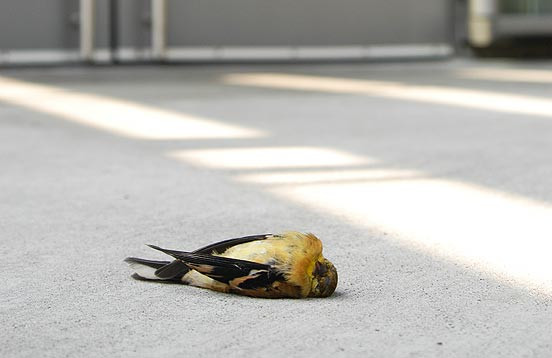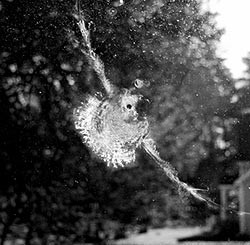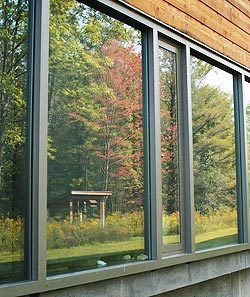Birds flying into windows is a distressing and surprisingly common issue for homeowners. You may have experienced the sudden thud of a bird hitting your window, leaving you concerned and wondering, “Why Does A Bird Keep Flying Into My Window?” It’s not just a random occurrence; there are specific reasons behind this behavior, and understanding them is the first step to preventing these tragic collisions. Unfortunately, these collisions are far more than just a nuisance; they represent a significant threat to bird populations. In fact, studies estimate that window strikes cause up to one billion bird deaths annually in the United States alone. This article delves into the reasons behind bird window collisions and provides practical, effective solutions to safeguard birds and your windows.
Understanding Bird Window Collisions: Daytime and Nighttime Dangers
 American goldfinch killed by window strike
American goldfinch killed by window strike
An American Goldfinch, a victim of a window strike. Window collisions are a leading cause of bird mortality.
Bird window collisions are broadly categorized into two types: daytime and nighttime strikes, each with distinct causes. During the day, the primary culprit is deception. Birds are highly attuned to their natural environment, navigating through complex landscapes with remarkable agility. However, windows, particularly clear and reflective glass, present a deceptive illusion.
Daytime Collisions: The Illusion of Open Space
Birds collide with windows during the day because they perceive reflections of their surroundings as real spaces. Windows mirror trees, vegetation, and the sky, creating the illusion of a continuous habitat. A bird seeing the reflection of trees might believe it’s a clear path to fly through, not realizing it’s a solid barrier. Similarly, seeing through a window to indoor plants or vegetation beyond can also be misleading. The bird aims for what appears to be an accessible patch of greenery, unaware of the invisible glass pane.
Large picture windows and windows positioned at right angles are particularly hazardous. These configurations amplify reflections, making the illusion of open space even more convincing for birds. Windows near bird feeders also pose a heightened risk. While feeders attract birds to your yard, they also inadvertently draw them closer to dangerous window surfaces. Contrary to previous beliefs about safe distances, even feeders placed relatively far from windows can still contribute to collisions if the windows themselves are not bird-safe.
Nighttime Collisions: The Lure of Artificial Light
Nighttime collisions primarily affect nocturnal migratory birds, which include a vast number of songbird species. Artificial lights in urban and suburban environments disorient these birds during their migrations. Instead of navigating by natural cues like stars, they become attracted to and confused by bright lights emanating from buildings and streetlights.
This attraction to artificial light is especially pronounced during low-ceiling or foggy conditions, where visibility is reduced. Birds drawn into brightly lit areas may become trapped, milling about and colliding with lighted structures, including windows. The consequences extend beyond immediate collisions. Birds diverted from their migratory paths by urban lighting may roost in less safe urban environments, only to face the daytime hazard of window reflections the following day. Organizations like the BirdCast project and the Fatal Light Awareness Program (FLAP) are dedicated to studying and mitigating the dangers of artificial light to migratory birds.
Territorial Behavior: Reflection Attacks
There’s another, less lethal, reason birds might fly into your windows: territorial aggression. Especially during the spring breeding season, birds, particularly males, become highly territorial. They may see their own reflection in a window and mistake it for a rival bird encroaching on their territory. This triggers aggressive behavior, leading them to repeatedly fly at and peck at the window reflection in an attempt to drive away the “intruder.” While this behavior can be persistent and annoying to homeowners, it rarely results in serious injury to the bird itself. Fortunately, many of the solutions designed to prevent window strikes caused by reflection illusions also effectively deter territorial reflection attacks.
 imprint of dove on plate glass window
imprint of dove on plate glass window
A window imprint left by a Mourning Dove after a collision. These imprints are stark reminders of the force and impact of window strikes.
How to Make Your Windows Bird-Safe: Effective Prevention Strategies
The good news is that you can take concrete steps to significantly reduce the risk your windows pose to birds. Making your windows bird-friendly involves disrupting the reflective or transparent nature of the glass, making it visible to birds. Here are several effective methods, suitable for both existing windows and new construction:
Treatments for Existing Windows: Simple and Effective Solutions
These solutions are designed to be applied to windows you already have, offering a range of options to suit different needs and aesthetics.
-
Markings on the Outer Surface: The key principle is to create visual patterns on the outside of the window that birds can perceive as a barrier. For smaller birds, markings should be spaced no more than 2 inches apart uniformly across the glass. For slightly larger patterns like Acopian BirdSavers, a spacing of 4 inches is effective due to their increased visibility.
-
Tempera Paint or Soap: A cost-effective and temporary solution is to use tempera paint or soap to create patterns directly on the window. You can use a simple 2×2 inch grid pattern or get creative with designs. These markings are easily washable and can be reapplied as needed.
-
Decals, Stickers, and Tape: Apply decals, stickers, sun catchers, mylar strips, or even masking tape to the exterior of the window. For these to be effective, dense spacing is crucial. A few widely spaced stickers, especially hawk silhouettes, are largely ineffective. The key is to cover a substantial portion of the glass surface with minimal gaps for birds to attempt to fly through.
-
Dot Patterns and Specialized Tapes: For a more durable and aesthetically subtle solution, consider specialized tapes with pre-spaced dot patterns. Products like Feather Friendly tapes are designed specifically for bird collision prevention and offer long-lasting effectiveness with easy application.
-
Acopian BirdSavers (Zen Curtains): These consist of closely spaced cords hanging vertically down the window. They act as a visual curtain, deterring birds while maintaining visibility for humans. Acopian BirdSavers are highly effective and relatively easy to install. They can be ordered pre-made or DIY versions can be created. The Cornell Lab of Ornithology headquarters uses this method to protect its windows, demonstrating their effectiveness.
-
Screens and Netting: Installing mosquito screens over windows provides excellent bird protection, provided they are mounted on the outside and cover the entire window surface. Similarly, netting placed a few inches away from the glass acts as a buffer, safely bouncing birds away from the window. Small mesh netting is preferable to prevent entanglement. Netting can be mounted on frames for easy installation and removal.
-
One-Way Transparent Film: Films like Collidescape are applied to the exterior of windows, making them appear opaque to birds from the outside while maintaining outward visibility from the inside. These films can also offer the added benefit of reducing sunlight penetration, potentially lowering cooling costs.
-
 reflection of foliage in window – hazard to birds
reflection of foliage in window – hazard to birds
Window reflections of trees and sky create a dangerous illusion for birds, leading to collisions.
Incorporating Bird-Safe Design in New Homes and Remodels
If you are building a new home or remodeling, you have the opportunity to integrate bird-friendly features from the outset, seamlessly blending safety with design.
-
External Shutters, Sun Shades, and Awnings: Install external shutters, sun shades, or awnings and use them strategically, especially during peak bird activity periods or when rooms are not in use. These not only reduce reflections but can also contribute to energy savings.
-
Exterior Screens on New Windows: When choosing new windows, consider options that incorporate screens on the entire exterior surface of the glass. This provides built-in bird protection without requiring additional treatments.
-
Interior Vertical Blinds: Using interior vertical blinds and keeping the slats partially closed can help break up reflections and reduce the transparency of windows.
-
Minimize Visual Paths to Sky and Greenery: In interior design, avoid creating direct visual paths through your house to outdoor greenery or the sky. For example, a bright window directly opposite a picture window can create the illusion of a clear fly-through path. Strategic placement of doors or shades can disrupt these visual pathways.
Lights Out Initiatives: Reducing Nighttime Hazards
For nighttime collisions, participating in “Lights Out” initiatives is a crucial step. These initiatives encourage turning off non-essential lights in buildings, particularly during bird migration seasons. Many cities are adopting “Lights Out” programs to reduce light pollution and protect migratory birds. Installing downward-facing outdoor lighting also minimizes light spill and reduces attraction for birds.
Helping a Bird That Has Hit Your Window
Despite preventative measures, window strikes can still occur. If you find a bird that has collided with your window, immediate action can improve its chances of survival. Even if a bird appears to fly away after a collision, it may have sustained internal injuries.
-
Capture and Contain: Approach the bird gently from behind and use both hands to carefully scoop it up. Small birds are fragile, so handle them gently but securely.
-
Prepare a Safe Container: Place the bird in an unwaxed paper bag or a small cardboard box lined with soft tissue or paper towel. Ensure the container is closed and place it in a dark, quiet, and warm location away from pets and children.
-
Do Not Handle, Feed, or Water: Avoid handling the bird more than necessary, and do not attempt to feed or give it water. Wild birds perceive humans as threats, and minimizing stress is crucial.
-
Contact a Wildlife Rehabilitator: Locate a licensed wildlife rehabilitator in your area using online directories. Contact them for guidance and instructions. They may be able to provide specialized care and increase the bird’s chances of recovery. If you cannot transport the bird, inform the rehabilitator, as they may have alternative options.
-
Release (If Instructed): If the rehabilitator advises you to release the bird, take it to a safe, wooded area away from buildings. Before releasing, observe its flight ability. If it doesn’t fly strongly, recapture it and contact the rehabilitator again for further advice.
By understanding why birds fly into windows and implementing these preventative and responsive measures, you can make a significant difference in protecting these vulnerable creatures and ensuring your home is a safe haven for birds.